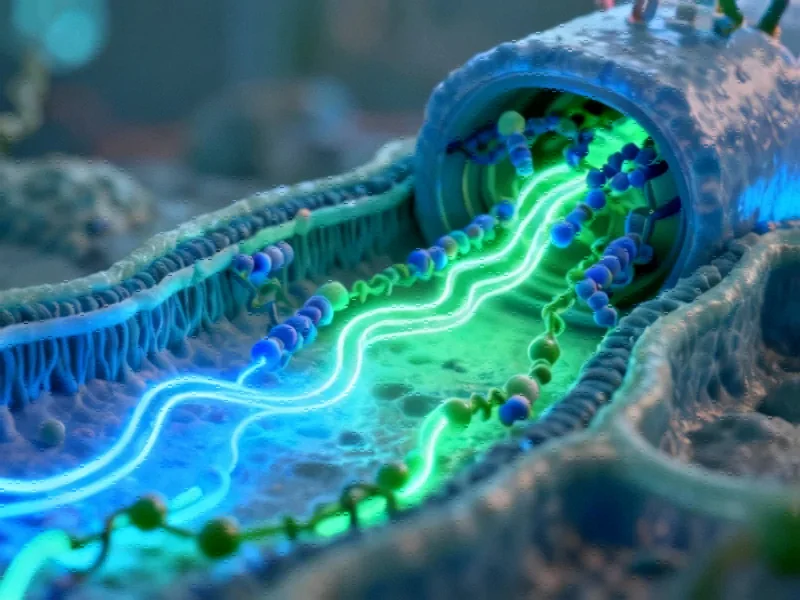Groundbreaking Structural Insights into Malaria’s Key Protein
In a landmark study that could reshape antimalarial drug development, scientists have successfully determined the first endogenous structure of PfATP4, a crucial cation pump in Plasmodium falciparum parasites. The 3.7 Å resolution cryo-EM structure, isolated directly from parasite-infected human red blood cells, reveals unprecedented molecular details about this primary antimalarial target and uncovers a previously unknown companion protein that appears essential for parasite survival.
The research, conducted using CRISPR-Cas9 modified parasites, provides the most accurate structural model of PfATP4 to date, significantly diverging from previous homology-based predictions. Unlike artificial expression systems, isolating the protein from its native environment enabled the discovery of PfATP4-Binding Protein (PfABP), a conserved protein of unknown function that may hold the key to understanding drug resistance mechanisms. This discovery comes at a critical time as researchers explore novel approaches to combat malaria through multiple avenues.
Architectural Revelations of PfATP4
The structural analysis reveals PfATP4’s organization into five canonical P-type ATPase domains, with the transmembrane domain consisting of 10 helices arranged similarly to other P2-type ATPases like SERCA and Na/K ATPase. The ion-binding site, located between TM4, TM5, TM6 and TM8, shows remarkable conservation with SERCA’s calcium-bound state, suggesting PfATP4 is captured in a sodium-bound conformation.
Notably, the ATP-binding site between the N- and P-domains maintains a conformation similar to ATP-free SERCA, with several critical sidechain differences that may explain PfATP4’s unique properties. These structural insights provide the foundation for understanding how protein regulation mechanisms function in pathogenic organisms and could inform broader biological applications.
Decoding Drug Resistance Mechanisms
The study offers crucial insights into how mutations in PfATP4 confer resistance to promising antimalarial candidates like Cipargamin and PA21A092. Resistance-conferring mutations primarily cluster around the sodium binding site within the transmembrane domain, with G358S/A mutations – identified in clinical trial recrudescent parasites – potentially blocking drug binding by introducing bulkier sidechains into the binding pocket.
Interestingly, the A211V mutation, which arose under pyrazoleamide pressure, increases susceptibility to Cipargamin, suggesting complex interactions between different drug classes. Understanding these resistance patterns is essential as the field advances toward commercial acceleration of biomedical innovations and more sophisticated therapeutic approaches.
The PfABP Discovery: A Game-Changing Companion
Perhaps the most significant finding is the identification of PfATP4-Binding Protein (PfABP), which interacts with TM9 of PfATP4. Through sophisticated modeling and mass spectrometry validation, researchers confirmed PF3D7_1315500 as this interacting partner, representing the third most abundant protein in their purified samples.
Functional studies demonstrate PfABP’s essential role in parasite biology. Conditional knockdown using the TetR-DOZI system revealed that PfABP depletion causes:
- >96% reduction in PfABP expression within 24 hours
- Severe parasite fitness defects after one replication cycle
- Marked reduction in PfATP4 protein levels
- Complete impairment of parasite survival
These findings establish a strict dependency of PfATP4 stability on its association with PfABP, revealing a vulnerable axis for therapeutic intervention. Such protein interactions represent exciting transformative developments in biological research that could have far-reaching implications.
Structural Interface and Evolutionary Significance
The PfATP4-PfABP interface features PfABP’s C-terminal domain with two short intermembrane helices packed against a long transmembrane helix, parallel to PfATP4-TM9. The interaction involves primarily van der Waals forces with a critical pi-pi stacking interaction between PfABP-T183 and PfATP4-W1089, surrounded by aromatic and positively charged residues.
Structural alignment reveals striking similarity to the NKA-γ-subunit interface, though PfABP lacks the canonical FXYD motif characteristic of sodium affinity modulators. Instead, PfABP appears to represent an apicomplexan-specific adaptation, suggesting unique regulatory mechanisms evolved in these parasites. This discovery highlights how biological systems develop specialized components to optimize their survival strategies.
Implications for Antimalarial Drug Development
The identification of PfABP as an essential modulator of PfATP4 stability opens new avenues for combating drug resistance. Rather than targeting PfATP4 directly, future therapeutics could disrupt the PfATP4-PfABP interaction, potentially overcoming existing resistance mechanisms. The structural details provide a blueprint for rational drug design targeting this critical interface.
As the field moves forward, these findings underscore the importance of studying proteins in their native context and the potential of targeting protein-protein interactions in infectious diseases. The research demonstrates how careful structural biology can reveal unexpected vulnerabilities in pathogens, contributing to broader strategic advances in medical science and therapeutic development.
This comprehensive structural and functional characterization of the PfATP4-PfABP complex represents a significant leap forward in understanding malaria parasite biology and provides multiple new targets for the next generation of antimalarial therapies capable of circumventing current resistance challenges.
This article aggregates information from publicly available sources. All trademarks and copyrights belong to their respective owners.
Note: Featured image is for illustrative purposes only and does not represent any specific product, service, or entity mentioned in this article.



